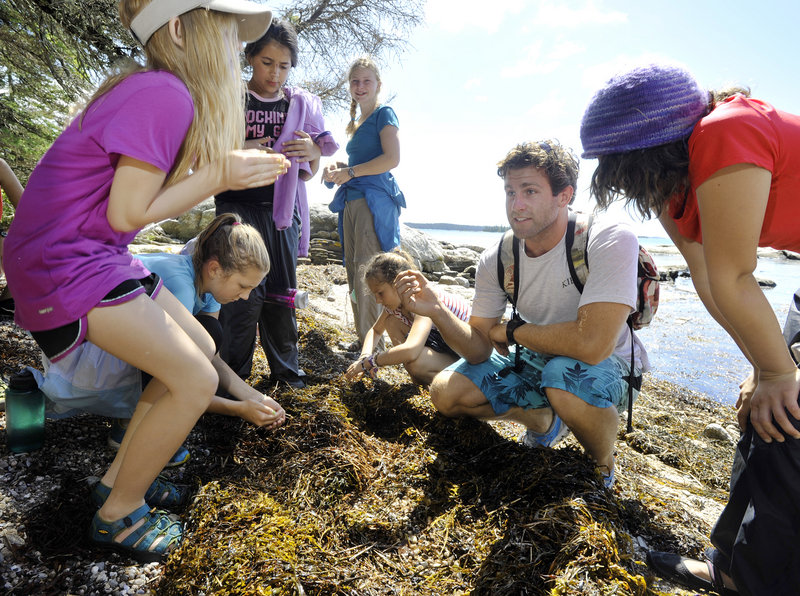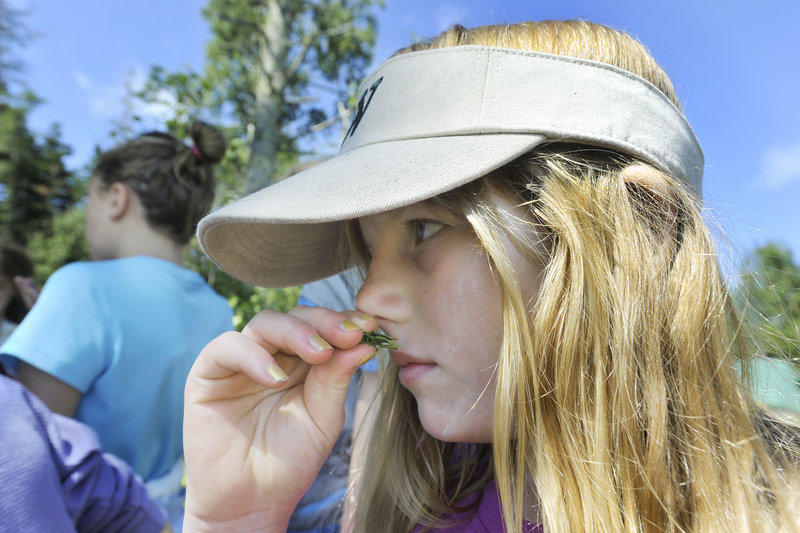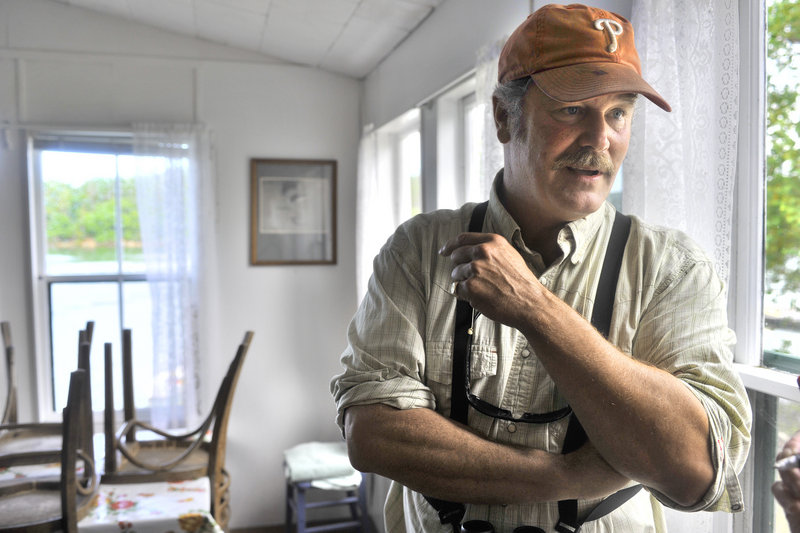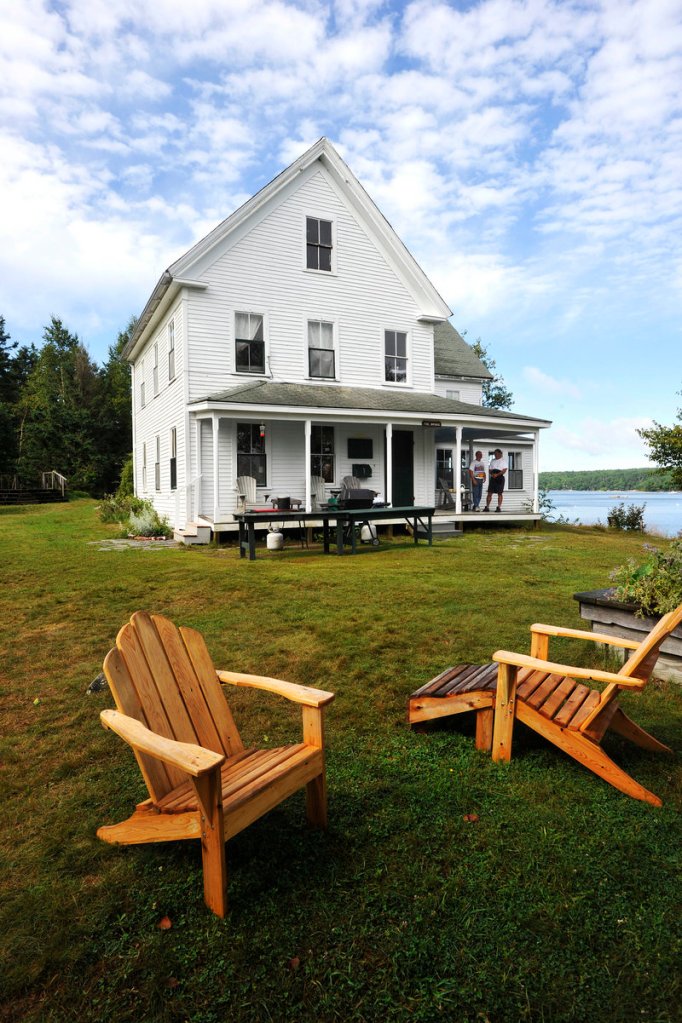BREMEN – The 13-year-old girls pulled back and shrieked. In the end, a good third ate the sand fleas that Ryan Pelletier held out.
The camp lesson on Wednesday taught an appreciation for nature by learning about edible leaves, shrubs and insects, what Pelletier calls, “trail nibbles.”
It also served as a kind of bountiful celebration.
The hike that taught campers a new way to appreciate nature comes at a time when historic Hog Island Camp is rebounding after years of uncertainty.
The 330-acre island camp that was a gift to National Audubon by Mabel Loomis Todd in 1936 has emerged from a rocky period of financial uncertainty and has become the focus of a group of determined supporters.
Today, three years after it closed, Hog Island Camp has a full slate of programs. While the counselor and environmental educator at nearby Camp Kieve-Wavus in Bremen are teaching leave-no-trace ethics and the marvels of the natural world now, adult birders in National Audubon programs are preparing to visit the island in the weeks ahead to observe the best of fall migration.
The partnership was the work of several groups, invested individuals and caring camp alumni, many of whom are closely tied because of their devotion to Hog Island. And each member of the interested parties says the rebirth of Hog Island Camp could not have happened without all these groups working together.
“This is a classic multi-partnership collaboration between groups,” said Alexander “Sandy” Buck, who sits on the board of trustees for both Maine Audubon and Kieve-Wavus, and was a Kieve camper years ago.
The tumultuous chapter in Hog Island’s story began in 2000 when National Audubon gave Maine Audubon the business of caring for its chapters and properties in Maine, including Hog Island Camps. The weighty task, coming just at the start of the recession, was tough to manage.
“Suddenly we had to figure out how to run a summer camp. We were struggling to keep the doors open. We had to close for a year to keep from bleeding money. That really attracted the attention of National Audubon,” Buck said.
Those closest to the island doing conservation work stepped forward, and one by one a group of determined, united supporters formed.
At the youth camp across a sliver of ocean, Kieve-Wavus director Henry Kennedy said Audubon campers should use his camp’s boat and captain to save costs. Kennedy also offered his camp’s staff as caretakers for the island and Hog Island Camp.
And since Kieve-Wavus campers had been using the island in an informal, low-impact way for years, it made sense to join the groups into a partnership focused on environmental education on Hog Island, Kennedy said.
“Closing it created a sense of urgency. And sharing resources made sense. We approached Maine Audubon and asked to formalize a partnership, to let us use the island,” Kennedy said.
Then, from the National Audubon office in New York, heralded Project Puffin founder Steve Kress joined the effort.
The man who in 1973 began to restore puffins to Maine islands wanted to restore this historic place of environmental learning, where he had worked since 1969.
Kress began to offer birding programs on the island again, at a cost to Project Puffin.
Buck said Maine Audubon took on the work of providing natural history teachers and workshops to train Hog Island staff.
And National Audubon and the Friends of Hog Island started raising money to save Hog Island Camp.
Suddenly, the quandary of creating an economically sustainable adult birding camp did not seem an insurmountable problem, said Pete Salmansohn, a teacher at Hog Island Camps since 1980 who works with Kress on Project Puffin.
This summer, Kieve-Wavus brings 1,000 campers through six week-long programs, in which a day or two are spent on Hog Island; and the Hog Island Audubon programs started again by Kress in 2010 are up to nine weeks this year.
Today, the future of the camp that dates to 1936 remains uncertain. But as several supporters gathered during a youth camp session early last week, the united effort wasn’t in question.
“Hog will thrive due to an ongoing collaboration with several partners sharing in the effort and reward,” Kennedy said.
As Salmansohn wandered through the camp’s newest building — the 1938 “Fish House” — where lectures, square dances and camp meetings take place, he was optimistic.
He pointed to the photos of past National Audubon directors, as well as Rachel Carson and the wealthy Todd family. The island’s history is steep, Salmansohn said, impossible to sum up in a morning. But he sensed a positive new chapter had begun and it would tell a new story.
“The history here goes back to the 1800s. The summer it closed was a sad, sad summer. But we started with four (Audubon) programs in 2010 and are up to nine this year. It’s working,” he said.
Staff Writer Deirdre Fleming can be contacted at 791-6452 or at:
dfleming@pressherald.com
Twitter: Flemingpph
Send questions/comments to the editors.







Success. Please wait for the page to reload. If the page does not reload within 5 seconds, please refresh the page.
Enter your email and password to access comments.
Hi, to comment on stories you must . This profile is in addition to your subscription and website login.
Already have a commenting profile? .
Invalid username/password.
Please check your email to confirm and complete your registration.
Only subscribers are eligible to post comments. Please subscribe or login first for digital access. Here’s why.
Use the form below to reset your password. When you've submitted your account email, we will send an email with a reset code.